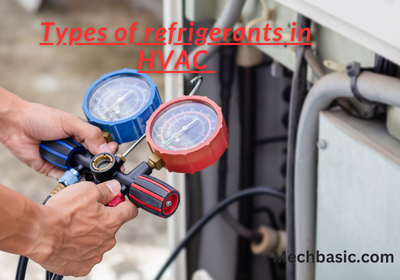In this article:
What is a Refrigerant?
A refrigerant is a chemical substance used in HVAC systems to absorb and release heat, enabling cooling and refrigeration. It circulates through the system, changing between liquid and gas states to transfer heat efficiently.
Function: he main function of the refrigerant is to absorb the heat from the indoor air, it transitions from a low-pressure gas to high-pressure liquid and transfer it to the atmosphere.

Properties of a Good Refrigerant?
A good Refrigerant must possess the following Properties:
Thermal Properties 🔥❄️
- High Latent Heat of Vaporization
- Low Boiling Point
- High Critical Temperature
Chemical Properties ⚗️
- Non-Corrosive
- Stable & Non-Flammable
- Compatible with Lubricants
Physical Properties ⚙️
- Low Viscosity
- High Thermal Conductivity
- Non-Toxic & Odorless
Environmental Properties 🌍
- Low Ozone Depletion Potential (ODP)
- Low Global Warming Potential (GWP)
Economic Properties 💰
- Low Cost & Availability
- Energy Efficiency
Types of Refrigerants in HVAC
Refrigerants are essential for heat transfer in HVAC systems. Over the years, different refrigerants have been developed, replaced, or phased out due to environmental concerns, efficiency, and safety.
| Refrigerant Type | Example | ODP (Ozone Depletion Potential) | GWP (Global Warming Potential) | Environmental Impact | Usage & Notes |
|---|---|---|---|---|---|
| CFCs (Chlorofluorocarbons) | R-12 | High | Very High (~10,000+ GWP) | Severe ozone depletion & greenhouse effect | Banned due to environmental harm. |
| HCFCs (Hydrochlorofluorocarbons) | R-22 | Moderate | High (~1,810 GWP) | Ozone depletion & global warming | Phased out; used in older AC units. |
| HFCs (Hydrofluorocarbons) | R-134a, R-410A | Zero | High (~1,300-2,000 GWP) | No ozone depletion but contributes to climate change | Common in modern ACs but being replaced. |
| HFOs (Hydrofluoroolefins) | R-1234yf, R-1234ze | Zero | Very Low (~4-10 GWP) | Eco-friendly alternative to HFCs | Used in new AC systems & automotive cooling. |
| Natural Refrigerants | R-290 (Propane), R-600a (Isobutane), R-717 (Ammonia), R-744 (CO₂) | Zero | Very Low (~1 or less GWP) | Best for the environment | Highly efficient but require safety precautions. |
Based on Chemical Composition
🔹 Chlorofluorocarbons (CFCs) – ❌ Banned due to high ozone depletion. (e.g., R-12)
🔹 Hydrochlorofluorocarbons (HCFCs) – 🚫 Phased out (e.g., R-22)
🔹 Hydrofluorocarbons (HFCs) – ✅ Common, but being phased down (e.g., R-134a, R-410A)
🔹 Hydrofluoroolefins (HFOs) – 🌍 Eco-friendly & low GWP (e.g., R-1234yf)
🔹 Natural Refrigerants – 🌱 Environmentally safe (e.g., R-290, CO₂)
Based on Safety Classification (ASHRAE Standard 34)
- A1 – Non-toxic, non-flammable (e.g., R-134a, R-410A)
- A2L – Low flammability (e.g., R-32, R-1234yf)
- A3 – Highly flammable (e.g., R-290 – Propane)
- B1/B2/B3 – Toxic and flammable (used in industrial applications)
Common Refrigerants in HVAC
| Refrigerant | Type | Ozone Depletion (ODP) | Global Warming (GWP) | Application | Phase Status |
|---|---|---|---|---|---|
| R-22 (Freon-22) | HCFC | High | 1,810 | Old AC & Heat Pumps | Phased Out (2020) |
| R-410A (Puron) | HFC | None | 2,088 | Modern Residential AC | Being Phased Down |
| R-134a | HFC | None | 1,430 | Automotive AC, Chillers | Being Phased Down |
| R-32 | HFC | None | 675 | New AC & Heat Pumps | Replacing R-410A |
| R-1234yf | HFO | None | 4 | Car AC, Residential HVAC | Preferred Replacement |
| R-1234ze | HFO | None | 1 | Chillers & Refrigeration | Eco-Friendly Option |
| R-290 (Propane) | Natural | None | 3 | Small AC Units, Freezers | Limited Use (Flammable) |
| R-744 (CO₂) | Natural | None | 1 | Supermarkets, Heat Pumps | High Pressure Needed |
Phase-Out & Future Trends
🚨 Why are R-22 and R-410A being phased out?
- Montreal Protocol bans ozone-depleting refrigerants like R-22.
- Kigali Amendment reduces high-GWP refrigerants like R-410A.
✅ Future refrigerants (Low-GWP & HFOs):
- R-32 → Leading R-410A replacement (50% lower GWP).
- R-1234yf & R-1234ze → New standard for eco-friendly cooling.
- CO₂ (R-744) & Hydrocarbons (R-290) → Natural, but require special handling.
How to chose the Right Refrigerant
✔ For Home AC: R-410A, R-32 (eco-friendly replacement).
✔ For Automotive AC: R-1234yf (low GWP).
✔ For Commercial Chillers: R-134a, R-1234ze.
✔ For Supermarkets & Freezers: R-744 (CO₂), R-290 (propane).
Other Courses:



